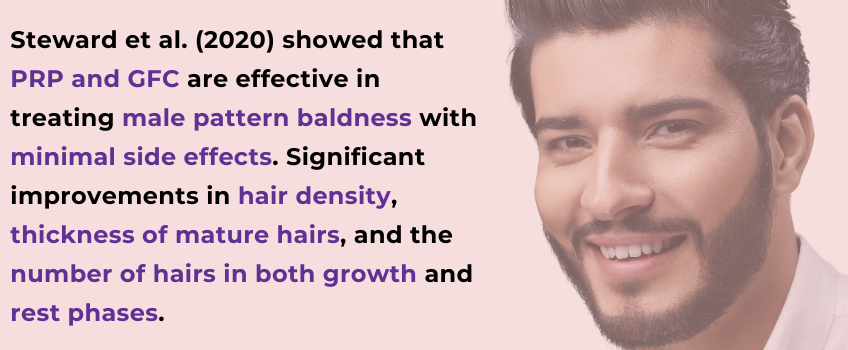
Does PRP work for genetic hair loss?
Male or female pattern baldness, also known as Androgenic alopecia (AGA), stands as the most prevalent form of hair loss, impacting a significant portion of the population – with estimates suggesting that up to half of us might experience it. The life cycle of a healthy hair follicle typically unfolds in three stages: the anagen phase (growth), the catagen phase (transition), and the telogen phase (rest). Ideally, 85% to 90% of our hair follicles are in the anagen phase, actively growing hair. However, this isn’t the case for individuals suffering from Androgenic Alopecia (AGA). In AGA patients, there’s a noticeable shortening of the anagen phase coupled with an extended telogen phase. This imbalance in the hair growth cycle leads to the hair loss characteristic of AGA.
This condition is rooted in genetics, passing down through families. The core issue in AGA lies in how the scalp’s hair follicles react to dihydrotestosterone (DHT). This sensitivity leads to the shrinking and eventual vanishing of hair follicles, culminating in noticeable hair loss. Hair loss, especially when it’s genetic, can be a significant concern for many. It’s not just a cosmetic issue but often affects self-esteem and confidence. Fortunately, medical science offers various solutions, one of the most promising being Platelet-Rich Plasma (PRP) therapy. Here, we explore five ways PRP works for genetic hair loss.
1. Natural Growth Factor Stimulation
PRP therapy works by harnessing the body’s natural healing abilities. PRP is loaded with various growth factors, such as epidermal growth factor, fibroblast growth factor, and several others. These growth factors play a crucial role in improving hair health in several ways. They help in the development and elongation of hair follicles, kickstart the growth phase of hair (anagen phase), promote the formation of new blood vessels (angiogenesis), and aid in the production of the extracellular matrix. Additionally, they are instrumental in the overall process of hair development and maturation. All these actions combined lead to enhanced hair growth, making PRP therapy a beneficial treatment for people with Androgenic Alopecia
In a randomized controlled trial, 30 women diagnosed with AGA were recruited to explore how effective PRP is as a single treatment option to enhance hair density, thickness, and overall appearance (Dubin et al., 2020). The findings were promising: PRP showed significant improvements in the thickness and density of hair, as well as in the overall look of the hair, when compared to a placebo treatment.
2. Improving Blood Supply to the Follicles
A healthy blood supply is vital for robust hair growth. PRP injections can increase blood flow to the hair follicles, providing them with more oxygen and nutrients. This enhanced blood supply not only supports the health of existing hair but also promotes the growth of new hair. By improving circulation, PRP therapy can create a more nurturing environment for hair follicles, combating the effects of genetic hair loss.
This factor is vital in understanding how does PRP work for genetic hair loss, as it directly impacts hair’s appearance and volume.A 2020 study examined if PRP works for genetic hair loss and found that the reduction in hair loss from PRP might be attributed to a more nutrient-rich environment provided by an enhanced blood supply to the hair cells (Butt et al., 2020).
3. Thickening and Strengthening Hair
Patients undergoing PRP therapy often notice that their hair becomes thicker and stronger. The growth factors in PRP can increase the diameter of the hair shaft, leading to fuller and healthier-looking hair. This is particularly beneficial for those whose hair has become thin and weak as a result of genetic hair loss. PRP can reverse some of these changes, making the hair appear more voluminous and vibrant. A 2020 study found that using PRP and GFC (Growth Factors Concentrate) effectively treats male pattern baldness, with minimal side effects.The authors ovserved a significant improvement in several key areas: the average density of hair, the density of fully developed (terminal) hairs, and the number of hairs in both the growth (anagen) and rest (telogen) phases (Steward et al., 2020).
4. Safe and Low-Risk Treatment
One of the most appealing aspects of PRP therapy is its safety profile. Since the treatment uses the patient’s own blood, there is a minimal risk of allergic reactions or infections. This makes PRP an excellent option for those who are hesitant about more invasive hair loss treatments or those who cannot tolerate certain medications used to treat genetic hair loss. The procedure is relatively quick, can be done in an outpatient setting, and typically requires minimal recovery time.
5. Complimenting Other Hair Restoration Treatments
PRP therapy can be used in conjunction with other hair loss treatments. For example, PRP hair restoration can be combined with medications like Minoxidil or Finasteride, or even after hair transplant surgery to enhance the results. This synergistic approach can be particularly effective in tackling genetic hair loss, as it addresses the issue from multiple angles.Research has showed that combining minoxidil, a common hair growth treatment, with PRP works even better for hair regrowth. This combo seems to boost the activity in the hair root cells and improves blood flow in the scalp (Alves & Grimalt, 2018;Shah et al., 2017). One study found that after 6 months, this combination not only resulted in more hair growth but also improved the ratio of growing to resting hairs, and left the patients more satisfied with their hair’s appearance
Conclusion
PRP therapy offers a promising solution for those grappling with genetic hair loss. Its ability to stimulate natural hair growth, improve scalp health, and strengthen existing hair, all while being a safe and minimally invasive procedure, makes it a preferred choice for many. As with any medical treatment, it’s important to consult with a healthcare professional to determine if PRP therapy is the right option for you. With continued research and advancements, PRP stands as a beacon of hope for many facing the challenges of hair loss.
Ready to Take Control of Your Hair Loss? Discover PRP Therapy!
If you’re searching for a solution to your hair loss woes, PRP therapy could be your answer. It’s not just about regaining hair; it’s about restoring confidence and satisfaction with your appearance. Why wait any longer to take the first step towards the fuller, healthier hair you deserve?
🌟 Consult with your team today to see if PRP therapy is right for you. Join the many who have found hope and success in this innovative treatment. Let’s turn the tide on hair loss together! 🌟
References
Alves, R., & Grimalt, R. (2018). Platelet-rich plasma in combination with 5% minoxidil topical solution and 1 mg oral finasteride for the treatment of androgenetic alopecia: A randomized placebo-controlled, double-blind, half-head study. Dermatologic Surgery, 44(1), 126–130.
Butt, G., Hussain, I., Ahmad, F. J., & Choudhery, M. S. (2020). Stromal vascular fraction‐enriched platelet‐rich plasma therapy reverses the effects of androgenetic alopecia. Journal of Cosmetic Dermatology, 19(5), 1078–1085.
Dubin, D. P., Lin, M. J., Leight, H. M., Farberg, A. S., Torbeck, R. L., Burton, W. B., & Khorasani, H. (2020). The effect of platelet-rich plasma on female androgenetic alopecia: A randomized controlled trial. Journal of the American Academy of Dermatology, 83(5), 1294–1297.
Girijala, R. L., Riahi, R. R., & Cohen, P. R. (2018). Platelet-rich plasma for androgenic alopecia treatment: A comprehensive review. Dermatology Online Journal, 24(7).
Shah, K. B., Shah, A. N., Solanki, R. B., & Raval, R. C. (2017). A comparative study of microneedling with platelet-rich plasma plus topical minoxidil (5%) and topical minoxidil (5%) alone in androgenetic alopecia. International Journal of Trichology, 9(1), 14.
Steward, E., Patel, H., Pandya, H., Dewan, H., Bhavsar, B., Shah, U., & Dholakia, K. (2020). Efficacy of platelet-rich plasma and concentrated growth factor in treating androgenetic alopecia—A retrospective study. Annals of Maxillofacial Surgery, 10(2), 409–416. https://doi.org/10.4103/ams.ams_154_19
To book your complimentary consultation appointment, call us at 416-548-6548 Book a Consultation


